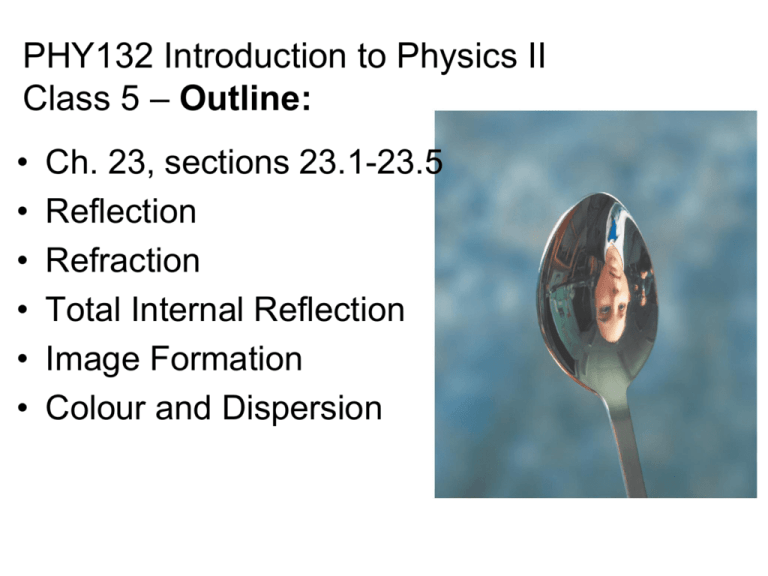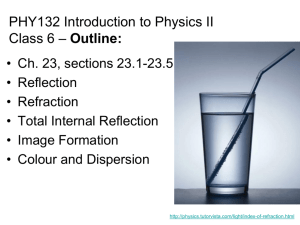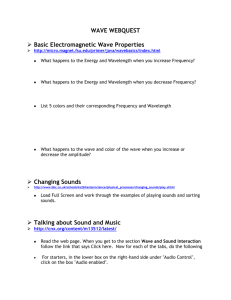PHY132 Introduction to Physics II
advertisement

PHY132 Introduction to Physics II Class 5 – Outline: • • • • • • Ch. 23, sections 23.1-23.5 Reflection Refraction Total Internal Reflection Image Formation Colour and Dispersion What is light? Light is an electromagnetic wave – and is highly useful in our everyday life! 300 B.C. – Euclid of Alexandria noted that light travels in straight lines, and wrote down the Law of Reflection for plane mirrors. (But Euclid believed that i r vision was due to our eyes emitting rays of light…) 1000 A.D. – Alhazen of Basra considered the law of reflection in 3-D, noting that the angles of incidence and reflection are in the same plane normal to the interface. Alhazen proved experimentally that vision is due to light proceeding to our eyes, from each point on an object. He also investigated refraction, pinhole cameras, and lenses. 1611 – Johannes Kepler discovered total internal reflection, and, in 1621, Willebrord Snel wrote down the Law of Refraction (Snell’s Law). Kepler Snel 1665 – Isaac Newton used a glass prism to disperse light and create a rainbow. He concluded that white light was composed of a mixture of a whole range of colours. Unfortunately, Newton advocated the idea that light was a stream of particles, not a wave phenomenon. 1801 – Thomas Young performed the doubleslit experiment showing light is a wave with a tiny wavelength (about half of a micron). Young also suggested that light was a transverse wave, and that it therefore could be polarized. (this is how 3D glasses work today!) 1864 – James Clerk Maxwell published his equations describing the dynamic relations of the electric and magnetic fields. Maxwell showed that disturbances in the electric and magnetic fields could propagate as a transverse wave, and he solved for the theoretical speed of this wave. This speed was very close to the current experimental value, justifying his theory that light was an electromagnetic wave. Electromagnetic Waves The electric and magnetic fields of an electromagnetic wave are perpendicular to each other and to the direction of motion of the wave. Electromagnetic Spectrum • In a vacuum, all electromagnetic waves move at the same speed • We classify electromagnetic waves according to their frequency (or wavelength) • Light is one kind of electromagnetic wave Electromagnetic Waves CHECK YOUR NEIGHBOUR If a certain material is “transparent” (ie, not opaque), what does this mean? A. Electromagnetic waves of all frequencies can pass straight through it B. Electromagnetic waves of all frequencies are reflected from its surface C. Electromagnetic waves of all frequencies are absorbed throughout its volume D. Electromagnetic waves of a certain frequency can pass straight through it Transparent Materials Glass blocks both infrared and ultraviolet, but it is transparent to visible light. Opaque Materials • Most things around us are opaque—they absorb light without re-emitting it. • Vibrations given by light to their atoms and molecules are turned into random kinetic energy—into internal energy. • These materials become slightly warmer. Opaque Materials Metals • Light shining on metal forces free electrons in the metal into vibrations that emit their own light as reflection. Reflection CHECK YOUR NEIGHBOUR Which reflects more light, a white piece of paper or a black piece of paper? A. B. C. Black White About the same Reflection CHECK YOUR NEIGHBOUR Which reflects more light, a white piece of paper or a mirror? A. B. C. White Paper Mirror About the same Specular Reflection Mirrors • The surface is flat at distance scales near or above the wavelength of light • It looks “shiny”, and you can see images in it. Diffuse Reflection White Paper • The surface is rough at distance scales near or above the wavelength of light • Almost all surfaces reflect in this way! Law of Specular Reflection The angle of reflection equals the angle of incidence. Mirror A B • A dentist uses a mirror to look at the back of a second molar (A). • Next, she wishes to look at the back of a lateral incisor (B), which is 90° away. • By what angle should she rotate her mirror? A. 90° B. 45° C. 180° Refraction When light bends in going obliquely from one medium to another, we call this process refraction. Cause of Refraction • Bending of light when it passes from one medium to another • Caused by change in speed of light A soldier wants to get from point 1 to Point 2 in the shortest amount of time. Marching through mud is much slower than marching on dry land. Which might be the best path? 1 Dry Land A B C Mud Dry Land 2 Refraction Light travels slower in glass than in air, so it minimizes the time it spends in the glass. Total Internal Reflection • Total reflection of light traveling within a medium that strikes the boundary of another medium at an angle at, or greater than, the critical angle Discussion Question • Light waves with speed v1 are incident upon the flat surface of a material in which they have speed v2. • For what condition is total internal reflection possible? A. v2 > v1 B. v2 < v1 C. v2 = v1 D. All of the above An Optical Fibre Speed of light in cladding is higher than speed of light in core. Medical Fibrescopes Videolaryngoscopy with a flexible fiberscope Virtual Image Formation No light rays actually pass through or even near the image, so it is “virtual”. Two plane mirrors form a right angle. How many images of the ball can the observer see in the mirrors? A. 1 B. 2 C. 3 D. 4 air water A fish swims below the surface of the water. An observer sees the fish at: A. a greater depth than it really is. B. its true depth. C. a smaller depth than it really is. air water A fish swims directly below the surface of the water. An observer sees the fish at: A. a greater depth than it really is. B. its true depth. C. a smaller depth than it really is. Color Color we see depends on frequency of light. 0.4 𝜇m High Frequency, Short wavelength 0.7 𝜇m 𝑓 𝜆 Low Frequency, Long wavelength Mixing Colored Light The spectrum of sunlight is a graph of brightness versus frequency. Dispersion • Process of separation of light into colors arranged by frequency • Components of white light are dispersed in a prism (and in a diffraction grating). Rainbows Rainbows are a result of dispersion by many drops. • Dispersion of light by a single drop Rainbows Antisun Radius of circle is about 41° Doublerainbow The second rainbow has blue on the top, and a radius of about 53° Rhodopsin is a transmembrane protein complex. Rods and cones contain stacks of membranes. Opsin (protein component) Cone Retinal (pigment) 0.5 µm Rod Light Rhodopsin Light The retinal molecule inside rhodopsin changes shape when retinal absorbs light. trans conformation (activated) cis conformation (inactive) Opsin Opsin Light Slide courtesy of Ross Koning, Biology Department, Eastern Connecticut State University http://plantphys.info/sciencematters/vision.ppt Response Curves for the three types of cones in the retina of the human eye. Slide from http://hyperphysics.phy-astr.gsu.edu/hbase/vision/colcon.html Stareboth Use at the eyes, stare at area shown in blue for 15 seconds or so dot on the nose for 15 seconds. What do you see on this blank white slide? Blink if needed! This is called an “after image” Does it move around as you move your gaze? Additive Primary Colours (light bulbs) and Subtractive Primary Colours (ink) Why the Sky Is Blue For small scattering particles, like nitrogen or oxygen molecules, higher frequency blue light is scattered much more readily than lower frequency red light. Why the Sky Is Blue 𝑓𝑟𝑒𝑞𝑢𝑒𝑛𝑐𝑦 Why Sunsets Are Red CHECK YOUR NEIGHBOUR If molecules in the sky scattered orange light instead of blue light, the sky would be A. B. C. D. orange. yellow. green. blue. Why Sunsets Are Red Light that is least scattered is light of low frequencies, which best travel straight through air. Why Sunsets Are Red CHECK YOUR NEIGHBOUR If molecules in the sky scattered orange light instead of blue light, sunsets would be A. B. C. D. orange. yellow. green. blue. Before Class 6 on Wednesday • Please read Knight Pgs. 670-686: Ch. 23, sections 23.6-23.8 • Please do the short pre-class quiz on MasteringPhysics by tomorrow night. • Something to think about: What is the difference between a converging and diverging lens? Which type can be used to focus sunlight onto a piece of paper and burn a hole?








